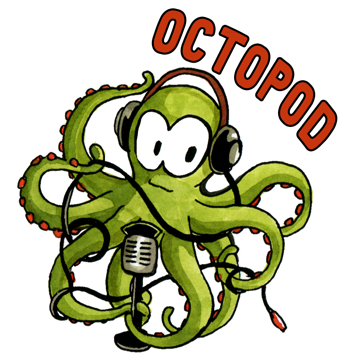Usage
Next, update the configuration settings in the configuration file _config.yml in the application
directory. (You are already in it.)
- You might want to change the images and logos in the
imgdirectory - You might want to change the demo episode file and the Jekyll Welcome post in
_postsand_episodes
You can find a documentation of all the non-Octopod-specific settings on the Configuration page of the Jekyll Documentation.
Jekyll is highly customizable, if you are into coding (or even just want to get into it), read the Jekyll Documentation. It is very detailed and quite easy to grasp.
First of all, your new podcast episode needs audio data. Octopod assumes that your ready to use
audio files stay within the episodes directory in your projects root.
$ cp ~/my_superduper_audio_files/ocp001.m4a episodesIn addition, jekyll-octopod assumes that the different audio files of each of your episodes are the same content in various formats — with the same duration and everything. If they are not, you may confuse your listeners — at least when you are using the chapters feature.
Next up, your episode needs some metadata. A title, some kind of a description, maybe chapters and
so on. jekyll-octopod keeps all these metadata in one single text file (Protip: these dear little
tots feel very lucky when they might live in a version control system!).
jekyll-octopod kindly helps you to generate these files with the octopod episode command. You
will get more information on the the command line tool later.
The following command
$ octopod episode --title "Why I <3 Octopod"will generate you a template called YYYY-MM-DD-why-i-_3-octopod.md (YYYY-MM-DD represents the current date) in your _posts subdirectory. When you open it in your text editor you’ll see something like this:
---
title: Why I <3 Octopod
subtitle: A Subtle Subtitle
image: "episode-cover0.jpg" # This can be used to provide episode-specific images
datum: March 22nd 2016 # this is no longer necessary, but in de or en installations, it is still respected
layout: post
author: Uncle Octopod
explicit: 'no'
duration: "0:03:13"
audio:
m4a: name.m4a
mp3: name.mp3
ogg: name.ogg
chapters:
- '00:00:00.000 Intro.'
- '00:00:30.000 Outro.'
posts-dir: "/path/to/post/dir" # default: '_posts'
---
##
{{ podigee_player page }}
## Shownotes and Links
* NoteThe part between the “—” and the “—” is the YAML front matter.
This is where all the metadata is stored. Below the YAML frontmatter is the area (body) where you
can write down your post’s content (like the show notes and stuff).
This strange looking {{ podigee_player page }} thingy is the
Liquid filter, which represents the iframe where the web player will be included
later.
When all this work is done you are ready to take a first look. The following command generates your site and starts a local webserver for a preview. You can check your new podcasting website by opening http://localhost:4000.
$ octopod --url "http://localhost:4000" --serverSince localhost:4000 is the default, a shorter command with the same result is:
$ octopod s[erve]If everything looks good, you can generate the site with the proper url from your configuration.
Warning: Don’t upload the _site subdirectory after serving it locally, as all links will assume
running on localhost and this will cause issues!
To build your site use
$ octopod b[uild]And deploy it to your server:
$ octopod deployWarning: The Rsync settings in your _config.yml are mandatory for this last step.
If you don’t wish to use rsync, uploading the website from the _site subdirectory via FTP or
whichever tool you prefer works just fine.
Jekyll Admin
We have also included Jekyll Admin, so you can create new posts and update existing ones using a web interface at http://localhost:4000/admin You could even change the config in the web interface.
To enable Jekyll admin uncomment the lines
# plugins:
# - jekyll-admin
in your project’s _config.yml file.
See the documentation of Jekyll Admin for details.
Unfortunately Jekyll Admin kills Jekyll’s auto regeneration feature. So if you prefer auto regeneration
over the web based admin, disable the gem all together by removing it from the plugin array in
the _config.yml file or commenting it in _config.yml.
Continue with The command line tool.
